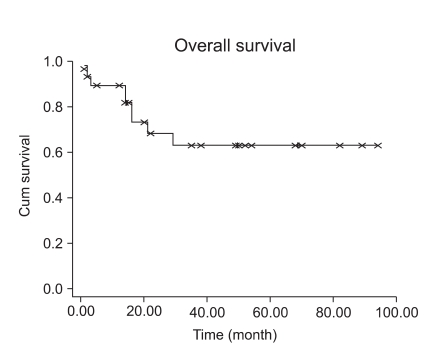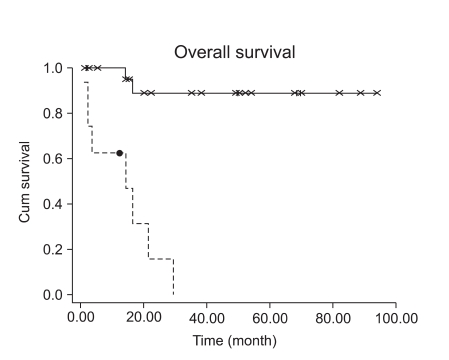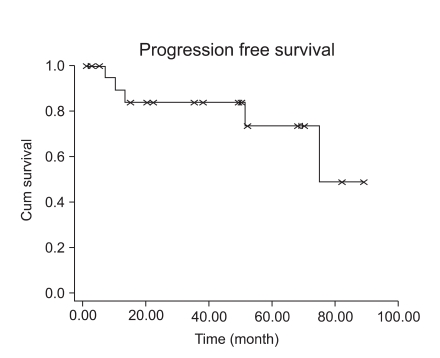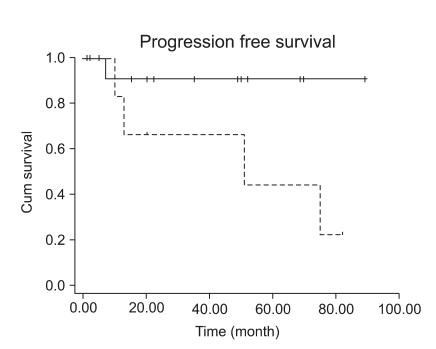Cancer Res Treat.
2009 Mar;41(1):24-28.
Uterine Leiomyosarcoma : 14-year Two-center Experience of 31 Cases
- Affiliations
-
- 1Department of Obstetrics and Gynecology, Ajou University Hospital, Suwon, Korea. hsryu@ajou.ac.kr, ds.bae@samsung.com
- 2Department of Pathology, Ajou University Hospital, Suwon, Korea.
- 3Department of Obstetrics and Gynecology, Samsung Medical Center, Sungkyunkwan University School of Medicine, Seoul, Korea. hsryu@ajou.ac.kr ds.bae@samsung.com
Abstract
-
PURPOSE: The aim of this study was to evaluate the clinicopathological characteristics of uterine leiomyosarcoma (LMS) and possible prognostic factors.
MATERIALS AND METHODS
This study included 31 patients with histologically proven LMS at Samsung Medical Center and Ajou University Hospital between 1994 and 2007. The medical records and available histological slides were reviewed retrospectively.
RESULTS
The median age was 46 years (range, 32~63). The most common symptom was vaginal bleeding (11 patients, 35.5%). There were 23 patients with stage I, one patient with stage III, seven patients with stage IV disease. The median follow up time was 29 months (range, 1~94). The most common recurrence site was lung (5 case), followed by pelvis and upper abdomen (2 case). Nine patients died of disease with a 5-year overall survival rate of 63%. Early tumor stage and mitotic count were the prognostic factor in univariate analysis (p<0.0001 and p=0.0031, respectively), but early tumor stage only was associated with prognosis in multivariate analysis (p=0.010 vs p=0.143). Adjuvant treatment for early stage disease did not decrease the recurrence rate (p=0.1075), but high mitotic count (15>10HPF) had a trend for disease recurrence in early stage LMS (p=0.0859).
CONCLUSION
Mitotic count less than 15/HPF in early stage may be related with longer progression-free interval, but we could not reach the conclusion that adjuvant therapy in early stage LMS be effective.
Keyword
MeSH Terms
Figure
Reference
-
1. Echt G, Jepson J, Steel J, Langholz B, Luxton G, Hernandez W, et al. Treatment of uterine sarcomas. Cancer. 1990; 66:35–39. PMID: 2354406.
Article2. Norris HJ, Zaloudek CJ. Blaustein A, editor. Mesenchymal tumors of the uterus. 1982. 2nd ed. New York: Springer-Verlag.3. Zaloudek CJ, Norris HJ. Kuman RJ, editor. Mesechymal tumors of the uterus. 1993. 4th ed. New York: Springer-Verlag.4. Livi L, Paiar F, Shah N, Blake P, Villanucci A, Amunni G, et al. Uterine sarcoma: twenty-seven years of experience. Int J Radiat Oncol Biol Phys. 2003; 57:1366–1373. PMID: 14630275.
Article5. Major FJ, Blessing JA, Silverberg SG, Morrow CP, Creasman WT, Currie JL, et al. A Gynecologic Oncology Group study. Prognostic factors in early-stage uterine sarcoma. Cancer. 1993; 71(4 Suppl):1702–1709. PMID: 8381710.6. Leibsohn S, d'Ablaing G, Mishell DR Jr, Schlaerth JB. Leiomyosarcoma in a series of hysterectomies performed for presumed uterine leiomyomas. Am J Obstet Gynecol. 1990; 162:968–974. PMID: 2327466.
Article7. Mayerhofer K, Obermair A, Windbichler G, Petru E, Kaider A, Hefler L, et al. Leiomyosarcoma of the uterus: a clinicopathologic multicenter study of 71 cases. Gynecol Oncol. 1999; 74:196–201. PMID: 10419731.
Article8. Berchuck A, Rubin SC, Hoskins WJ, Saigo PE, Pierce VK, Lewis JL Jr. Treatment of uterine leiomyosarcoma. Obstet Gynecol. 1988; 71(6 Pt 1):845–850. PMID: 2453004.9. Schwartz Z, Dgani R, Lancet M, Kessler I. Uterine sarcoma in Israel: a study of 104 cases. Gynecol Oncol. 1985; 20:354–363. PMID: 2982707.
Article10. Kempson RL, Bari W. Uterine sarcomas. Classification, diagnosis, and prognosis. Hum Pathol. 1970; 1:331–349. PMID: 4330001.11. Fleming WP, Peters WA 3rd, Kumar NB, Morley GW. Autopsy findings in patients with uterine sarcoma. Gynecol Oncol. 1984; 19:168–172. PMID: 6489828.
Article12. van Nagell JR Jr, Hanson MB, Donaldson ES, Gallion HH. Adjuvant vincristine, dactinomycin, and cyclophosphamide therapy in stage I uterine sarcomas. A pilot study. Cancer. 1986; 57:1451–1454. PMID: 3948125.
Article13. Giuntoli RL 2nd, Bristow RE. Uterine leiomyosarcoma: present management. Curr Opin Oncol. 2004; 16:324–327. PMID: 15187886.
Article14. Goff BA, Rice LW, Fleischhacker D, Muntz HG, Falkenberry SS, Nikrui N, et al. Uterine leiomyosarcoma and endometrial stromal sarcoma: lymph node metastases and sites of recurrence. Gynecol Oncol. 1993; 50:105–109. PMID: 8349151.
Article15. Giuntoli RL 2nd, Metzinger DS, DiMarco CS, Cha SS, Sloan JA, Keeney GL, et al. Retrospective review of 208 patients with leiomyosarcoma of the uterus: prognostic indicators, surgical management, and adjuvant therapy. Gynecol Oncol. 2003; 89:460–469. PMID: 12798712.
Article16. Sutton G, Blessing JA, Malfetano JH. Ifosfamide and doxorubicin in the treatment of advanced leiomyosarcomas of the uterus: a Gynecologic Oncology Group study. Gynecol Oncol. 1996; 62:226–229. PMID: 8751554.
Article17. Giuntoli RL 2nd, Garrett-Mayer E, Bristow RE, Gostout BS. Secondary cytoreduction in the management of recurrent uterine leiomyosarcoma. Gynecol Oncol. 2007; 106:82–88. PMID: 17434579.
Article18. Blom R, Guerrieri C, Stal O, Malmstrom H, Simonsen E. Leiomyosarcoma of the uterus: a clinicopathologic, DNA flow cytometric, p53, and mdm-2 analysis of 49 cases. Gynecol Oncol. 1998; 68:54–61. PMID: 9454661.
Article19. Nola M, Babic D, Ilic J, Marusic M, Uzarevic B, Petrovecki M, et al. Prognostic parameters for survival of patients with malignant mesenchymal tumors of the uterus. Cancer. 1996; 78:2543–2550. PMID: 8952563.
Article20. Larson B, Silfversward C, Nilsson B, Pettersson F. Prognostic factors in uterine leiomyosarcoma. A clinical and histopathological study of 143 cases. The Radiumhemmet series 1936-1981. Acta Oncol. 1990; 29:185–191. PMID: 2334571.
Article21. Wu TI, Chang TC, Hsueh S, Hsu KH, Chou HH, Huang HJ, et al. Prognostic factors and impact of adjuvant chemotherapy for uterine leiomyosarcoma. Gynecol Oncol. 2006; 100:166–172. PMID: 16182349.
Article22. Bazzocchi F, Brandi G, Pileri S, Mancuso A, Massaro A, Martinelli G. Clinical and pathologic prognostic features of leiomyosarcoma of the uterus. Tumori. 1983; 69:75–77. PMID: 6836752.
Article23. Salazar OM, Bonfiglio TA, Patten SF, Keller BE, Feldstein M, Dunne ME, et al. Uterine sarcomas: natural history, treatment and prognosis. Cancer. 1978; 42:1152–1160. PMID: 698910.
- Full Text Links
- Actions
-
Cited
- CITED
-
- Close
- Share
- Similar articles
-
- Myxoid leiomyosarcoma of the uterus: a case report and review of the literature
- Two Cases of Primary Uterine Leiomyosarcoma:MR Findings and Pathologic Correlation
- Uterine leiomyosarcoma in a captive capybara (Hydrochoerus hydrochaeris): a case report
- Ultrasonographic Findings of Uterine Leiomyosarcoma: Differentiation from Leiomyoma
- Uterine leiomyosarcoma in a cat





